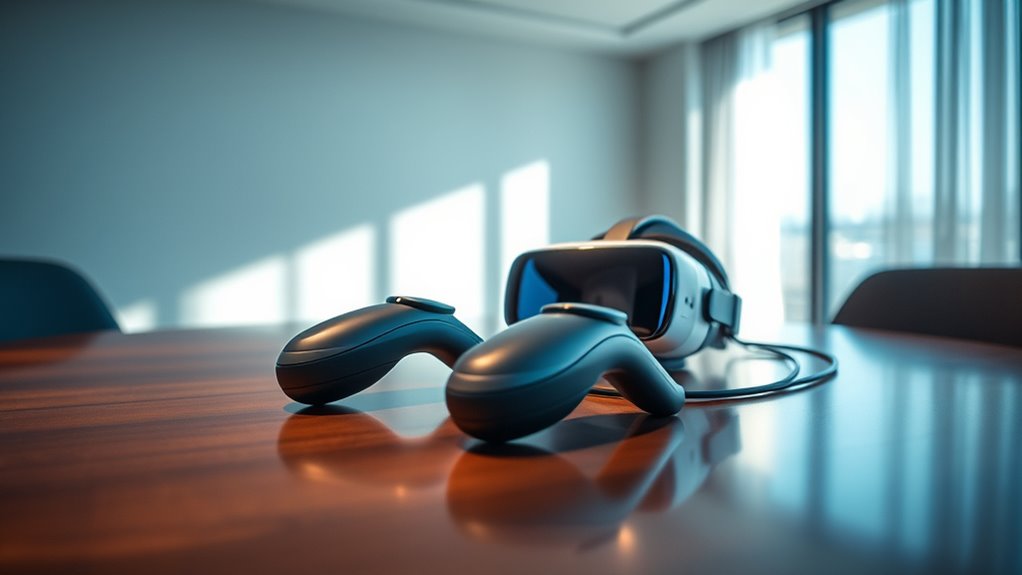To connect your VR controllers to your headset, first verify your headset is charged and ready. Next, charge your controllers, keeping their battery between 20%-80%. Enter pairing mode on both devices, then press the pairing button on the controllers until the lights flash. In your headset’s Bluetooth settings, select each controller to complete the pairing. Finally, test the connection to confirm everything’s working. For more detailed guidance, there’s more to uncover ahead.
Prepare Your VR Headset
Before you connect your VR controllers, you’ll need to prepare your headset. Start with the headset setup by making sure it’s charged and ready for use. Check your device compatibility; not all headsets work with every controller, so refer to the manufacturer’s guidelines.
Next, adjust the straps and fit to confirm comfort during your VR experience. Clean the lenses to avoid any obstructions that could hinder your immersion. If your headset has built-in audio, make certain it’s functioning properly, as sound is essential for a fully immersive environment. Finally, update the headset firmware if needed to guarantee the best performance. Once you’ve completed these steps, you’ll be ready to plunge into the virtual world with your controllers.
Charge Your Controllers
Charge your controllers to guarantee they’re ready for action. To keep your gaming sessions uninterrupted, it’s essential to maintain your controllers’ batteries. Follow these charging tips: always use the recommended charger to avoid damaging the battery. Avoid letting the battery drain completely before recharging; lithium-ion batteries work best when kept between 20% and 80% charged. Consider establishing a routine, like charging your controllers after each use, to assure peak battery maintenance. If you’re not using them for an extended period, store them with a charge level between 40% and 60%. This way, you’ll enjoy a longer lifespan for your controllers and be ready to plunge into immersive experiences whenever you want.
Enter Pairing Mode
Once your controllers are charged and ready, the next step is to enter pairing mode. Start by checking your headset settings to find the pairing options. Depending on your headset, there may be different pairing methods available—like automatic detection or manual input. Choose the method that suits you best.
Now, activate pairing mode on your controllers; usually, this involves pressing and holding a specific button until a light blinks. If you’re having trouble, don’t worry—check your headset’s compatibility or verify both devices are within range. Keep these troubleshooting tips in mind: restart both the headset and controllers, and confirm they’re fully charged. Following these steps will make for a seamless connection experience.
Connect the Controllers
Now that you’ve entered pairing mode, connecting the controllers is a straightforward process. Follow these simple steps for your controller setup and enjoy seamless wireless connectivity:
- Activate Controllers: Press and hold the pairing button on each controller until you see the indicator light flash. This means they’re ready to connect.
- Select Your Device: On your headset, navigate to the Bluetooth settings. Look for your controllers in the list of available devices.
- Pair the Controllers: Select each controller from the list to complete the pairing process. Once connected, the lights will stabilize, confirming a successful connection.
That’s it! You’re now ready to plunge into your VR adventures with your controllers fully connected.
Test the Connection
To guarantee your controllers are properly connected, it’s time to test the connection. Start by launching your VR headset and guiding to the settings menu. Look for an option related to controller compatibility; this will help verify everything’s in sync. Once you find it, select the option to calibrate or test the controllers. Move and press buttons on each controller, observing any on-screen responses. If they don’t respond, try re-pairing them, confirming they’re charged and within range. If you still face issues, consult the troubleshooting tips specific to your headset model. Remember, keeping your software up-to-date can also resolve connection problems. Enjoy the freedom of immersive experiences—just verify your controllers are ready to go!
Frequently Asked Questions
What Should I Do if My Controllers Won’T Pair?
If your controllers won’t pair, try a controller reset. Did you know 30% of pairing issues stem from Bluetooth interference? Confirm no other devices are nearby and restart both your headset and controllers for better connectivity.
Can I Connect Multiple Controllers to One Headset?
You can’t connect multiple controllers to one headset due to headset limitations. Each headset typically supports only a specific number of devices, so focus on proper controller pairing for ideal performance with your current setup.
How Do I Know if My Headset Software Is up to Date?
To check if your headset software’s up to date, go to the headset settings. Look for software updates; it’ll let you know if any updates are available or if you’re already current.
Are There Compatibility Issues With Different VR Systems?
You’d think all VR systems would play nice, but compatibility factors can trip you up. Always check system requirements before diving in, or you might find yourself stuck in a virtual world without your controllers.
What Types of Batteries Do the Controllers Use?
Your VR controllers typically use AA or rechargeable lithium-ion batteries. The choice of battery types affects controller lifespan; rechargeable batteries often provide longer usability, while disposable ones can be convenient but require frequent replacements.

